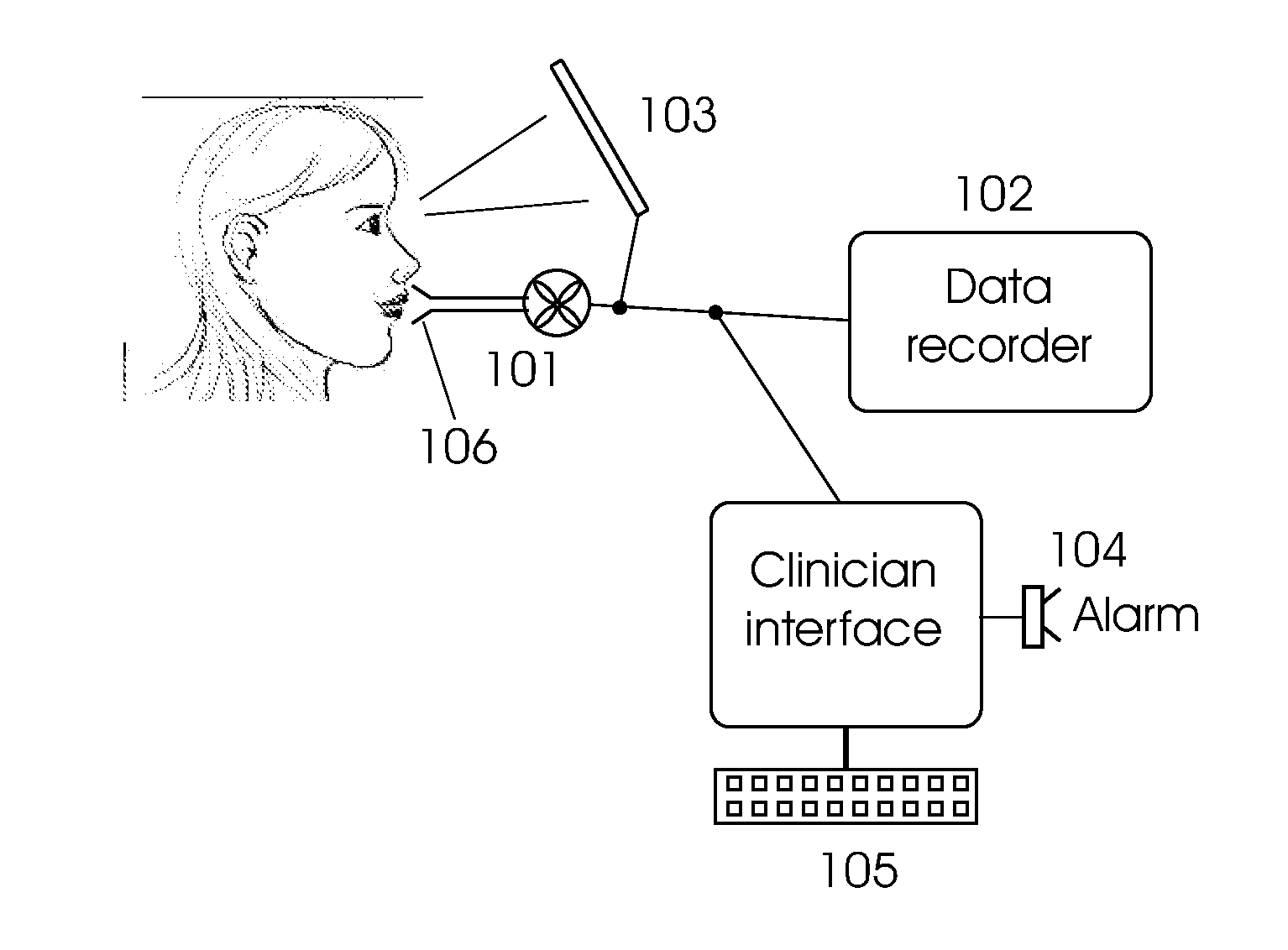Monitoring incentive spirometry
a spirometry and incentive technology, applied in the field of incentive spirometry and the prevention of pulmonary complications, can solve the problems of reducing frc, hospital patients and postoperative surgical patients, in particular, at significant risk for a variety of pulmonary complications, and achieve the effect of facilitating complian
- Summary
- Abstract
- Description
- Claims
- Application Information
AI Technical Summary
Benefits of technology
Problems solved by technology
Method used
Image
Examples
example 1
Incentive Spirometry for Surgical Patients
[0049]A typical scenario is for a patient in a hospital ward recovering from major surgery of the chest or abdomen. As previously discussed, such patients are frequently at significant risk of pulmonary complications during their postoperative recovery. The following program is prescribed by the patient's physician:
[0050]The measurement unit should have a typical measurement range of about 0-4000 ml. The patient is instructed to perform sets of ten deep inhalations repeated at hourly intervals during waking hours where each inhalation should take 4-12 seconds (alternatively definable as a flow rate of, e.g., 200-600 ml / sec) and achieve a target inhalation volume of at least 1500-2500 ml. The patient is instructed to keep the lungs full at maximum capacity for 1-2 seconds. Performance expectation may also be downgraded depending on the clinical status of the patient. Patient performance can be displayed on a local display to assist the patien...
example 2
Monitoring Incentive Spirometry in Patients with Chronic Lung Disease
[0052]As with postsurgical patients, there is a need for monitoring compliance and measuring efficacy of IS for patients with chronic lung disease who did not necessarily have surgery. In this group of patients, IS is believed to improve arterial blood gases and health-related quality of life in patients with Chronic Obstructive Pulmonary Disease (COPD), even though it may not be observe to alter pulmonary function parameters. [Basoglu et al. 2005] A program of IS can be prescribed for either an inpatient or outpatient setting as appropriate. Target performance and alarm setting can be similar to those for the postsurgical patients of Example 1, although there may be more need for individual adjustment according to the residual lung function and therapeutic needs of these patients.
[0053]In addition, any degradation in performance can be noted and flagged early in order to provide further treatment before the patien...
example 3
Clinical Trial Utilizing Monitored Incentive Spirometry
[0054]Embodiments of the present invention can also be used to enable clinical trials to be conducted for determination of efficacy of IS programs to prevent pulmonary complications. A cohort of patients undergoing thoracic or abdominal surgery is recruited. The cohort is divided into two arms matched for surgery type, gender and age: one arm (control) receives standard hospital post-operative care (excluding explicit respiratory therapy); the second group (IS) receives IS with monitoring both during hospitalization and continuing until three weeks after surgery as described in Example 1.
[0055]Primary outcome measures include reductions in episodes of community acquired pneumonia (CAP) and related severe respiratory complications (atelectasis) during the surgical recovery period (three weeks after surgery).
[0056]Secondary outcome measures include reductions in hospitalizations due to a primary diagnosis of respiratory complicati...
PUM
 Login to View More
Login to View More Abstract
Description
Claims
Application Information
 Login to View More
Login to View More - R&D
- Intellectual Property
- Life Sciences
- Materials
- Tech Scout
- Unparalleled Data Quality
- Higher Quality Content
- 60% Fewer Hallucinations
Browse by: Latest US Patents, China's latest patents, Technical Efficacy Thesaurus, Application Domain, Technology Topic, Popular Technical Reports.
© 2025 PatSnap. All rights reserved.Legal|Privacy policy|Modern Slavery Act Transparency Statement|Sitemap|About US| Contact US: help@patsnap.com


